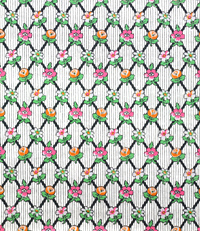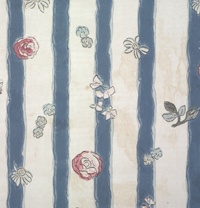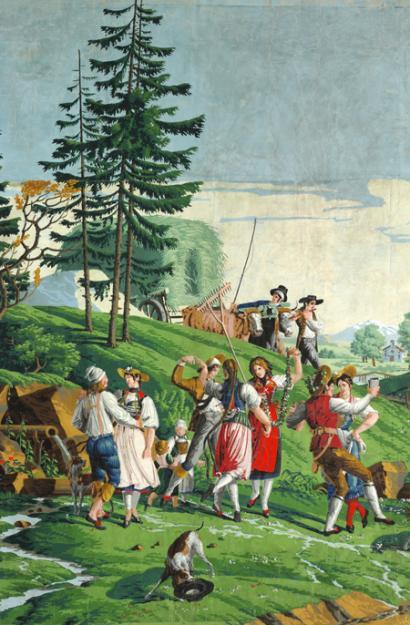How do we decorate our walls? This exhibition, devoted to the use of wallpaper in interior decoration in Switzerland, traces its evolution from the earliest paper wall coverings of the 16th century to the contemporary creations of artists such as Olivier Mosset and Francis Baudevin. It reveals some previously unseen treasures from the Swiss National Museum’s collection. This innovative and interactive exhibition offers opportunities for visitors to experience at first hand the fascinating world of wallpaper. After initially showing at Château de Prangins, the exhibition will move to the Swiss National Museum in Zurich in 2012.
 Wallpaper with a flowered lattice motif from a house in Frauenfeld. Unknown factory, c. 1910- 1915. Machine print, 100 x 50 cm © Swiss National Museum.
Divided into eight sections, the exhibition at Château de Prangins explores the history of a type of decoration that originated in England and achieved its greatest popularity in France from the 1780s onwards. There is everything from opulent 18th-century block prints – some of them bearing the hallmark of the prestigious royal factory Réveillon – to the industrially produced rolls from the late 19th century, with their historical or art nouveau motifs. One of the undoubted attractions will be the side-by-side presentation of two famous scenic wallpapers produced by the Zuber company: Grande Helvétie and Petite Helvétie. Printed using engraved wooden blocks, they are a testimony to the success of scenic wallpapers, which were widely used between 1800 and 1860 to decorate walls with fantastic landscapes. Both remind us that although Switzerland produced little or no wallpaper of its own, it inspired creations that were exported throughout the world. The exhibition also examines the technical advances, such as the development of continuous paper rolls and machine printing, which enabled the production of cheap wall coverings and thus made wallpaper available to a wider audience.
Arabesque and Switzerland feed the inspiration
The first section of the exhibition evokes the atmosphere of an art restoration workshop, reminding visitors that wallpaper is a fragile and short-lived material that is difficult to preserve and protect against the ravages of time. The second section deals with the golden age of wallpaper. The industry had its origins in England, but reached its apogee in France from the 1780s onwards. The motifs produced were so sophisticated and the printing quality so high that they appealed to even the wealthiest classes of society, who came to prefer them over costly silks, not least because they could be replaced more frequently. The most important source of inspiration was Antiquity; this is most clearly seen in the famous "arabesque" motifs, some of which bear the mark of Réveillon, the prestigious royal factory in Paris. Scenic wallpapers, which covered all four walls of a room with a fantastic landscape, were one of the great success stories of wallpaper in the early 19th century (Section 3) and Switzerland was an especially popular subject. Section 4 represents a wallpaper shop displaying rolls, samples, model albums and advertising materials, reflecting the increased popularity of wallpaper among the public at large during the 19th century when production costs fell markedly, particularly for the so-called “sanitary” wallpapers which were washable and therefore more hygienic.
 Fragment of wallpaper with a motif of stylised flowers and stripes from Château de Prangins. Unknown factory, c. 1920-1930. Machine print. © Swiss National Museum.
At the start of the 20th century some manufacturers revived the tradition of hand printing using blocks (Section 5). They often sought the assistance of celebrated artists. A classic example of this is the Genevan manufacturer Henri Grandchamp, who commissioned works by the finest artists of the era (Cingria, Bischoff, etc.). Some of his papers were hung at Château de Prangins. Next section shows that wallpaper is currently undergoing an extraordinary renaissance. Distinguished modern practitioners of the craft include the Swiss artists Olivier Mosset and Francis Baudevin. Section 7 studies the origins of wallpaper in Switzerland. As early as the second half of the 16th century, the so-called Fladerpapiere, which imitated marquetry on wood, were used to decorate beams, walls and doors. The Swiss National Museum has preserved a fine set of such papers. The last area focuses on the wallpapers of Château de Prangins. In 1975, when the château was handed over to the Swiss Confederation for restoration and transformation into the home of the Swiss National Museum in western Switzerland, much of its interior was decorated with wallpaper. The oldest fragments found date back to the 1760s; the most recent are from the 1930s. Around a hundred motifs have been recorded. These wallpapers are a key element of the château’s heritage and a vital historical record.
PUBLICATION:
A lavishly illustrated catalogue published in French and German by the Bibliothèque des Arts (Lausanne), accompanies the exhibition (184 pages, 180 ill. in four colors, CHF 49.-). The catalogue is available in the museum shop or can be ordered from info.prangins@snm.admin.ch
To see more illustrations, click on VERSION FRANCAISE at the top
of this page
|










